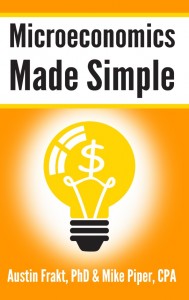My book on basic microeconomics, coauthored by Mike Piper, is out. It’s called Microeconomics Made Simple and, as the title suggests, it’s a gentle introduction to the basics. At just 100 pages, it’s a quick read.
I want you to buy it, to read it, to love it, and to tell your friends, family members, and social media followers about it.
Here are some possible reasons why you might be interested in the book:
- You never learned microeconomics and yearn for a basic intro that won’t take much time or make your brain hurt
- You learned microeconomics, but so long ago you’re rusty and want to brush up
- You’re a student, with a microeconomics course in your future and you want to get a jump on the basic concepts
- You’re taking a microeconomics course right now, but it’s going too fast for you and you want a simple way to review the fundamentals
- You will be or are taking some other social science or business course for which a basic understanding of microeconomics would be helpful, even if it’s not required
- You find yourself puzzled by some discussions of markets or profits or opportunity cost or other microeconomic concepts and want a way to get up to speed
- You teach microeconomics or some other social science or business course and you think some or all of your students could benefit from access to a gentle introduction to microeconomics
- You want a quick way to understand the limitations of economics (yeah, we cover that too)
For a limited time, the Kindle price will be discounted from $4.99 to $0.99. You can buy the book at Amazon.com. Below are some additional details, including a table of contents and links to excerpts.
Summary
Part One, explains the most fundamental concepts of microeconomics, such as utility, supply, demand, market equilibrium, and some ways in which governments intervene in markets.
Part Two focuses on the degree of competition in different types of markets, as well as the outcomes of competition. Market structures considered include: perfect competition, monopolies, oligopolies, and monopolistic competition.
The Authors
My coauthor, Mike Piper, is a certified public accountant and an expert at distilling complex topics into simple language and examples. This is his eighth book that does so (others here) and his blog on personal finance is excellent. As you know, I’m a health economist and, as such, have devoted a great deal of my professional life thinking about microeconomic concepts. We teamed up to explain all the microeconomics we could in 100 pages.
Special thanks go to Wade Pfau and Julian Jamison for contributing their time and expertise for technical editing.
Excerpts
Click on the following links for excerpts. Note that each is out of context. The book assumes no prior knowledge of economics so, in the context of the book, each excerpt is fully accessible to a non-expert.
- The law of diminishing marginal utility
- How to calculate economic profit
- The Four Factors of Production (on Mike’s blog)
- Marginal Revenue for a Monopoly (on Mike’s blog)
- Consumer and Producer Surplus (on Mike’s blog)
Errata
Please bring errors in the book to our attention. As we find and fix them, we’ll post the details here.
Table of Contents
Introduction:
What Is Economics?
Macroeconomics vs. Microeconomics
Not a Perfect Model
Part One: Basic Economic Concepts
1. Maximizing Utility
What about Charity?
Decreasing Marginal Utility
Opportunity Cost
2. Evaluating Production Possibilities
Production Possibilities Frontier
Absolute Advantage and Comparative Advantage
3. Demand
Elasticity of Demand
Change in Demand vs. Change in Quantity Demanded
4. Supply
How Costs of Production Affect Supply
Elasticity of Supply
Change in Supply vs. Change in Quantity Supplied
5. Market Equilibrium
How Market Equilibrium Is Reached
The Effect of Changes in Supply and Demand
6. Government Intervention
Price Floors and Price Ceilings
Taxes and Subsidies
Part Two: Firm Behavior in Different Types of Markets
7. Costs of Production
Marginal Cost of Production
Fixed vs. Variable Costs
Short Run vs. Long Run
Sunk Costs Are Irrelevant
Economic Costs vs. Accounting Costs
Average Total Costs
8. Perfect Competition
Firms Are Price Takers
Making Decisions at the Margin
Calculating Profit or Loss
Zero Economic Profits in the Long Run
Firms Producing at Their Lowest Cost
Producing at a Loss in the Short Run
Consumer and Producer Surplus
9. Monopoly
Monopolies Have Market Power
Marginal Revenue Curve for a Monopoly
Maximizing Profit (Producing at MC = MR)
Profits and Losses for Monopolies
Monopolies: Producing at a Higher Cost
Loss of Surplus with a Monopoly
Monopolies and Government
10. Oligopoly
Firms Are Not Price Takers
Collusion in an Oligopoly
Cheating the Cartel
Government Intervention in Oligopolies
11. Monopolistic Competition
Making Decisions at the Margin
No Profits in the Long Run
Firms Do Not Produce at Lowest Cost
Loss of Surplus with Monopolistic Competition
Conclusion: The Insights and Limitations of Economics
Appendix A: Helpful Resources
Appendix B: Glossary
Acknowledgments
Other Books in the Series



